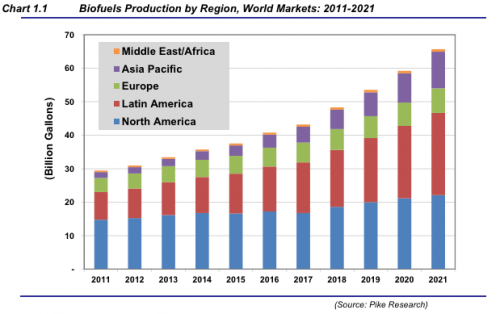Report: Global Biofuels Market Could Double To $185.3 Billion By 2021
 A new report from Pike Research predicts the global biofuels market will double over the next decade, from $82.7 billion in 2011 to $185.3 billion in 2021. Even with this rapid growth, however, significant hurdles remain and could prevent the industry from meeting government mandates.
A new report from Pike Research predicts the global biofuels market will double over the next decade, from $82.7 billion in 2011 to $185.3 billion in 2021. Even with this rapid growth, however, significant hurdles remain and could prevent the industry from meeting government mandates.The new report, Biofuels Markets and Technologies, estimates steady growth though 2016 but rapid production increases between 2017 and 2021 as a result of higher oil prices, emerging mandates, new feedstock availability, and advanced technologies. Total global biofuel production is projected to reach 65.7 billion gallons per year (BGPY) by 2021, and ethanol is expected to maintain its dominance over the industry, with nearly 50 BGPY compared to biodiesel’s 16.2 BGPY.
Several key markets are driving industry growth. Blending mandates now exist in at least 38 countries and 29 states or provinces around the world. The United States, Brazil, and European Union are the three largest markets, and represented 85 percent of global production in 2010. North America led the world in biofuel production with 48 percent of the global market, while the EU accounted for 49 percent of global biodiesel production.

Even with this rapid growth, the industry still may not meet total market needs by 2021. Production volumes are expected to fall short of the estimated 71.8 BGPY biofuels market demand because of a lack of access to inexpensive feedstocks and difficulty obtaining financing.
This failure to meet demand may be more of a reflection on the immense global transportation fuel market than the validity of biofuel technology. Pike Research estimates that by 2021 the global gasoline market will reach 375 BGPY, the global diesel ground transportation market will hit 427 BGPY, and aviation and marine fuel demand could add 200 BGPY to the global market.
Even if the biofuels industry does double current production levels, which hit 29.4 BGPY in 2011, they would still only represent seven percent of the total transportation fuel market.

The technological maturation of first-generation biofuel sources (such as corn, sugarcane, rapeseed and soy), combined with a second generation of fuel sources could increase production estimates even further. “The emergence of advanced conversion pathways and non-food feedstocks could unlock considerable production potential throughout the world,” says the report.
According to Pike, the combination of maturing investments, growing demand, and industry consolidation mean a bullish future for biofuels. “Given the scale of development to date and the crystallization of interests… widespread biofuels commercialization is no longer a question of if but when.”
You can return to the main Market News page, or press the Back button on your browser.

